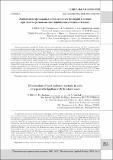| dc.contributor.author | Чезлова, Ольга Евгеньевна | |
| dc.contributor.author | Волчек, Александр Александрович | |
| dc.coverage.spatial | Киров | ru_RU |
| dc.date.accessioned | 2022-03-04T08:50:35Z | |
| dc.date.available | 2022-03-04T08:50:35Z | |
| dc.date.issued | 2021 | |
| dc.identifier.citation | Чезлова, О. Е. Элиминация фекальных индикаторных бактерий в почвах при многократном поливе животноводческими стоками / О. Е. Чезлова, А. А. Волчек // Теорeтическая и прикладная экология. – 2021. – № 2. – С. 235–241. – Библиогр.: с. 240–241 (19 назв.). – DOI: 10.25750/1995-4301-2021-2-236-242 | ru_RU |
| dc.identifier.uri | https://rep.bstu.by/handle/data/26880 | |
| dc.description | О. E. Chezlova, А. A. Volchak. Elimination of fecal indicator bacteria in soils at repeated irrigation with livestock waste | ru_RU |
| dc.description.abstract | Оценена динамика отмирания Escherichia coli, бактерий группы кишечной палочки (БГКП) и энтерококков
в сельскохозяйственных почвах при поливе сточными водами свинокомплекса нормами 90, 180 и 270 м3/га трижды
в течение вегетационного периода. К концу периода по показателям БГКП и энтерококков гигиенический норматив превышен на 2 порядка при нормах 180 и 270 м3/га. Для описания динамики численности микроорганизмов
использована аппроксимация первого порядка. Определены время 90%-ной элиминации и константы скорости
отмирания бактерий. Для первого полива стоками регрессионные зависимости имели преимущественно высокий
коэффициент детерминации от 0,7 до 0,9. Наибольшая скорость отмирания отмечалась у E. coli: константа отмирания
k находилась в диапазоне от 0,129 до 0,253 день-1 и время 10-кратного сокращения численности от 17,9 до 10,4 дней
при нормах полива 90 и 180 м3/га соответственно. Для энтерококков параметр k варьировал от 0,092 до 0,149 день-1,
а время 90%-ной элиминации от 25,1 до 15,4 дней при нормах полива 90 и 270 м3/га соответственно. Для БГКП при
поливе нормой 90 м3/га k = 0,131 день-1, а время 90%-ной элиминации 17,6 дня. К третьему поливу стоками скорость
элиминации E. coli, энтерококков и БГКП снижалась – константа k уменьшалась в среднем в 4,45; 3,79 и 2,12 раза
соответственно. Для адекватного описания динамики фекальных индикаторных бактерий в почвах земледельческих
полей орошения необходимо учитывать климатические, почвенные факторы, объём внесения стоков и др. | ru_RU |
| dc.language.iso | ru | ru_RU |
| dc.publisher | ООО "О-Краткое" | ru_RU |
| dc.subject | санитарно-показательные бактерии | ru_RU |
| dc.subject | полив сточными водами | ru_RU |
| dc.subject | модели | ru_RU |
| dc.subject | sanitary-indicative bacteria | ru_RU |
| dc.subject | sewage irrigation | ru_RU |
| dc.subject | models | ru_RU |
| dc.title | Элиминация фекальных индикаторных бактерий в почвах при многократном поливе животноводческими стоками | ru_RU |
| dc.type | Статья (Article) | ru_RU |
| dc.identifier.udc | 631.4 | ru_RU |
| dc.abstract.alternative | To determine the survival time of fecal indicator bacteria (coliform bacteria, Escherichia coli and enterococci) in
soils, a field experiment was conducted on sod-podzolic gley soil on cohesive sand when disposing of wastewater from
livestock farms. During the field season, wastewater was introduced three times by the norms of 90, 180 and 270 m3/ha. By
the end of the vegetation period, the content of coliform bacteria in the soil using the norms of 180 and 270 m3/ha is 2.17 · 102
and 2.16 · 102 CFU/g, respectively; the number of enterococci is 3.94 · 102 CFU/g and 2.17 · 102 CFU/g, respectively.
To describe the dynamics of the number of microorganisms, a first order approximation was used. During the first irrigation
with wastewater, the highest withering rate was observed in E. coli: the extinction constant k was in the range
0.129 to 0.253 day-1, and the time of a 10-fold reduction in numbers was from 17.9 to 10.4 days with irrigation rates of
90 and 180 m3/ha, respectively. For enterococci, the parameter k ranged from 0.092 to 0.149 day-1, and the time of 90%
elimination ranged from 25.1 to 15.4 days with irrigation rates of 90 and 270 m3/ha, respectively. For coliform bacteria
with a watering rate of 90 m3/ha, k = 0.131 day-1, and the time of 90% elimination is 17.6 days. By the third irrigation
with wastewater, the rate of elimination of E. coli, enterococci and coliform bacteria decreased – the constant k decreased
by an average of 4.45, 3.79 and 2.12 times, respectively. For an adequate description of the dynamics of indicator bacteria
in soils, it is necessary to take into account climatic, soil factors, the amount of wastewater, etc. | ru_RU |
| dc.identifier.doi | https://doi.org/10.25750/1995-4301-2021-2-236-242 | |
